A Model-Assisted Combined Machine Learning Method for Ionospheric TEC Prediction
Abstract
1. Introduction
2. Materials and Methods
2.1. Materials
2.1.1. Data Collection
2.1.2. Data Processing
2.2. Methods
2.2.1. TEC Prediction Based on the IRI Model
2.2.2. TEC Prediction Based on Statistical Machine Learning
2.2.3. Modeling of Neural Network Optimization Based on Genetic Algorithm
3. Results and Discussion
- Mean Absolute Error (MAE)
- Mean Relative Error (MRE)
- Root Mean Square Error (RMSE)
- Correlation Coefficient ()
- According to the high solar activity year (2015), low solar activity year (2020) and the mean values of the two years of performance indicators, the IRI model has the largest prediction error; the SML-based model has a slightly better prediction effect than the IRI model; MMAdapGA-BP-NN has the smallest prediction error and the best effect among all models.
- The prediction results of all models are generally slightly better in a low solar activity year (2020) than in a high solar activity year (2015). The MAE, MRE, RMSE, and ρ of MMAdapGA-BP-NN decreased by 86.21%, 53.91%, 70.07%, and 3.30% in a low solar activity year (2020) compared with high solar activity year (2015).
- In the year of high solar activity (2015), the MAE, MRE, RMSE, and ρ of MMAdapGA-BP-NN decreased by 45.28%, 57.26%, 52.27%, and 21.33% compared with the IRI model. In the year of low solar activity (2020), the MAE, MRE, RMSE, and ρ of MMAdapGA-BP-NN decreased by 85.42%, 80.58%, 72.13%, and 20.51% compared with the IRI model. On the whole, the MAE, MRE, RMSE, and ρ of MMAdapGA-BP-NN decrease by 58.87%, 51.84%, 58.01%, and 21.05% compared with the IRI model. Based on the above data, it is concluded that MMAdapGA-BP-NN is reliable for a long period of time.
- In the year of high solar activity (2015), the MAE, MRE, RMSE, and ρ of MMAdapGA-BP-NN decreased by 25.91%, 27.86%, 28.82%, and 10.98% compared with BP-NN. In the year of low solar activity (2020), the MAE, MRE, RMSE, and ρ of MMAdapGA-BP-NN decreased by 31.71%, 41.39%, 24.11%, and 14.63% compared with BP-NN. Overall, the MAE, MRE, RMSE, and ρ of MMAdapGA-BP-NN decreased by 26.58%, 29.07%, 36.60%, and 9.52% compared with BP-NN. Based on the above data, it can be seen that the optimization effect of MMAdapGA on BP-NN is very obvious. Moreover, the optimization effect of MMAdapGA on BP-NN in a high solar activity year (2015) is more obvious than that in a low solar activity year (2020).
- MMAdapGA-BP-NN results of 50 runs generally have smaller RMSE, larger ρ, and better prediction accuracy.
- In the year of high solar activity (2015), the average number of iterations converging for 50 running times of MMAdapGA-BP-NN, GA-BP-NN, and BP-NN are 19.5, 32.7, and 40.3, respectively. In the year of low solar activity (2020), the average number of iterations converging for 50 running times of the three models are 15.0, 23.3, and 33.5, respectively. MMAdapGA-BP-NN has fewer iterations and faster training speed.
- In the year of high solar activity (2015), the standard deviations of iterations converging for 50 running times of MMAdapGA-BP-NN, GA-BP-NN, and BP-NN are 3.71, 3.95, and 4.12. The standard deviations of RMSE of the three models are 1.46, 2.15, and 3.57. The standard deviations of ρ of the three models are 0.08, 0.14, and 0.34, respectively. In the year of low solar activity (2020), the standard deviations of iterations converging for 50 running times of the three models are 2.14, 2.34, and 5.02. The standard deviations of RMSE of the three models are 0.74, 1.03, and 1.46. The standard deviations of ρ of the three models are 0.06, 0.12, and 0.23, respectively. Compared with GA-BP-NN and BP-NN, MMAdapGA-BP-NN has a lower standard deviation of performance indexes, and the training effect is more stable. Moreover, the three models are generally more stable in the low solar activity year (2020) than in the high solar activity year (2015).
4. Conclusions
Author Contributions
Funding
Data Availability Statement
Conflicts of Interest
References
- Ware, R.; Fulker, D.; Stein, S.; Anderson, D.; Avery, S.; Clark, R.; Droegemeir, K.; Kuettner, J.; Minster, B.; Sorooshian, S. SuomiNet: A Real–Time National GPS Network for Atmospheric Research and Education. Bull. Am. Meteorol. Soc. 2000, 81, 677–694. [Google Scholar] [CrossRef]
- Komjathy, A.; Yang, Y.-M.; Meng, X.; Verkhoglyadova, O.; Mannucci, A.; Langley, R. Review and Perspectives: Understanding Natural-Hazards-Generated Ionospheric Perturbations Using GPS Measurements and Coupled Modeling: Natural-Hazards-Caused Tec Perturbations. Radio Sci. 2016, 51, 951–961. [Google Scholar] [CrossRef]
- Liu, L.; Wan, W.; Chen, Y.; Le, H. Solar Activity Effects of the Ionosphere: A Brief Review. Chin. Sci. Bull. 2011, 56, 1202–1211. [Google Scholar] [CrossRef]
- Priyadarshi, S. A Review of Ionospheric Scintillation Models. Surv. Geophys. 2015, 36, 295–324. [Google Scholar] [CrossRef] [PubMed]
- Yao, Y.; Zhang, S.; Kong, J. Research Progress and Prospect of GNSS Space Environment Science. Cehui Xuebao/Acta Geod. Cartogr. Sin. 2017, 46, 1408–1420. [Google Scholar] [CrossRef]
- Zhang, H.; Ping, J.; Zhu, W.; Huang, C. Brief Review of the Ionospheric Delay Models. Prog. Astron. 2006, 24, 16–26. [Google Scholar]
- Wang, X.; Zhu, W. Methods and Progress on Monitoring Ionosphere Activity by GPS. Prog. Astron. 2003, 21, 33–40. [Google Scholar]
- Bilitza, D.; Reinisch, B. International Reference Ionosphere 2007: Improvements and New Parameters. Adv. Space Res. 2008, 42, 599–609. [Google Scholar] [CrossRef]
- Bilitza, D.; Altadill, D.; Truhlik, V.; Shubin, V.; Galkin, I.; Reinisch, B.; Huang, X. International Reference Ionosphere 2016: From Ionospheric Climate to Real-Time Weather Predictions: IRI-2016. Space Weather. 2017, 15, 418–429. [Google Scholar] [CrossRef]
- Bilitza, D.; Mckinnell, L.-A.; Reinisch, B.; Fuller-Rowell, T. The International Reference Ionosphere (IRI) Today and in the Future. J. Geod. 2011, 85, 909–920. [Google Scholar] [CrossRef]
- Wang, J.; Shi, Y.F.; Yang, C.; Feng, F. A Review and Prospects of Operational Frequency Selecting Techniques for HF Radio Communication. Adv. Space Res. 2022, 69, 2989–2999. [Google Scholar] [CrossRef]
- Wang, J.; Ma, J.; Huang, X.; Bai, H.; Chen, Q.; Cheng, H. Modeling of the Ionospheric Critical Frequency of the F2 Layer over Asia Based on Modified Temporal-Spatial Reconstruction. Radio Sci. 2019, 54, 680–691. [Google Scholar] [CrossRef]
- Wang, J.; Feng, F.; Bai, H.; Cao, Y.; Chen, Q.; Ma, J. A Regional Model for the Prediction of M(3000)F2 over East Asia. Adv. Space Res. 2020, 65, 2036–2051. [Google Scholar] [CrossRef]
- Liu, Y.; Wang, J.; Yang, C.; Zheng, Y.; Fu, H. A Machine Learning-Based Method for Modeling TEC Regional Temporal-Spatial Map. Remote Sens. 2022, 14, 5579. [Google Scholar] [CrossRef]
- Hu, A.; Zhang, K. Using Bidirectional Long Short-Term Memory Method for the Height of F2 Peak Forecasting from Ionosonde Measurements in the Australian Region. Remote Sensing 2018, 10, 1658. [Google Scholar] [CrossRef]
- Wang, J.; Yang, C.; An, W. Regional Refined Long-Term Predictions Method of Usable Frequency for HF Communication Based on Machine Learning Over Asia. IEEE Trans. Antennas Propag. 2021, 70, 4040–4055. [Google Scholar] [CrossRef]
- Dinov, I. Deep Learning, Neural Networks. In Data Science and Predictive Analytics: Biomedical and Health Applications Using R; Springer: Cham, Switzerland, 2023; pp. 773–901. ISBN 978-3-031-17482-7. [Google Scholar]
- Mukhtarov, P.; Pancheva, D.; Andonov, B. Hybrid Model for Long-Term Prediction of the Ionospheric Global TEC. J. Atmos. Sol. Terr. Phys. 2014, 119, 1–10. [Google Scholar] [CrossRef]
- Liu, J.; Chen, R.; Wang, Z.; An, J.; Hyyppä, J. Long-Term Prediction of the Arctic Ionospheric TEC Based on Time-Varying Periodograms. PLoS ONE 2014, 9, e111497. [Google Scholar] [CrossRef]
- Oyeyemi, E.; Mckinnell, L.-A.; Poole, A. Near-Real Time FoF2 Predictions Using Neural Networks. J. Atmos. Sol. Terr. Phys. 2006, 68, 1807–1818. [Google Scholar] [CrossRef]
- Wichaipanich, N.; Hozumi, K.; Supnithi, P.; Tsugawa, T. A Comparison of Neural Network-Based Predictions of FoF2 with the IRI-2012 Model at Conjugate Points in Southeast Asia. Adv. Space Res. 2017, 59, 2934–2950. [Google Scholar] [CrossRef]
- Barkhatov, N.; Revunov, S.; Vertogradov, G.; Vertogradov, V.; Valov, V.; Uryadov, V. Prediction of the Maximum Observed Frequency of the Ionospheric HF Radio Channel Using the Method of Artificial Neural Networks. Geomagn. Aeron. 2006, 46, 84–93. [Google Scholar] [CrossRef]
- Zhao, J.; Li, X.; Liu, Y.; Wang, X.; Zhou, C. Ionospheric FoF2 Disturbance Forecast Using Neural Network Improved by a Genetic Algorithm. Adv. Space Res. 2019, 63, 4003–4014. [Google Scholar] [CrossRef]
- Song, R.; Zhang, X.; Zhou, C.; Liu, J.; He, J. Predicting TEC in China Based on the Neural Networks Optimized by Genetic Algorithm. Adv. Space Res. 2018, 62, 745–759. [Google Scholar] [CrossRef]
- Huang, Z.; Li, Q.B.; Yuan, H. Forecasting of Ionospheric Vertical TEC 1-h Ahead Using a Genetic Algorithm and Neural Network. Adv. Space Res. 2015, 55, 1775–1783. [Google Scholar] [CrossRef]
- Li, W.; Zhao, D.; He, C.; Hu, A.; Zhang, K. Advanced Machine Learning Optimized by The Genetic Algorithm in Ionospheric Models Using Long-Term Multi-Instrument Observations. Remote Sens. 2020, 12, 866. [Google Scholar] [CrossRef]
- Jia, W.; Zhao, D.; Ding, L. An Optimized RBF Neural Network Algorithm Based on Partial Least Squares and Genetic Algorithm for Classification of Small Sample. Appl. Soft Comput. 2016, 48, 373–384. [Google Scholar] [CrossRef]
- Hu, X.; Zhou, C.; Zhao, J.; Liu, Y.; Liu, M.; Zhao, Z. The Ionospheric FoF2 Prediction Based on Neural Network Optimization Algorithm. Dianbo Kexue Xuebao/Chin. J. Radio Sci. 2018, 33, 708–716. [Google Scholar] [CrossRef]
- Space Weather Prediction Center. Available online: https://www.swpc.noaa.gov (accessed on 7 November 2022).
- Reinisch, B.; Galkin, I. Global Ionospheric Radio Observatory (GIRO). Earth Planets Space 2011, 63, 377–381. [Google Scholar] [CrossRef]
- Global ionosphere Radio Observatory. Available online: https://giro.uml.edu/didbase/scaled.php (accessed on 16 October 2022).
- Pignalberi, A.; Pietrella, M.; Pezzopane, M.; Rizzi, R. Improvements and Validation of the IRI UP Method under Moderate, Strong, and Severe Geomagnetic Storms. Earth Planets Space 2018, 70, 180. [Google Scholar] [CrossRef]
- Habarulema, J.; Ssessanga, N. Adapting a Climatology Model to Improve Estimation of Ionosphere Parameters and Subsequent Validation with Radio Occultation and Ionosonde Data: Improving the Climatological Model Performance. Space Weather 2016, 15, 84–98. [Google Scholar] [CrossRef]
- Community Coordinated Modeling Center. Available online: https://kauai.ccmc.gsfc.nasa.gov (accessed on 21 December 2022).
- Ghaffari-Razin, S.R.; Voosoghi, B. Wavelet Neural Networks Using Particle Swarm Optimization Training in Modeling Regional Ionospheric Total Electron Content. J. Atmos. Sol. Terr. Phys. 2016, 149. [Google Scholar] [CrossRef]
- Sidorenko, K.A.; Kondratyev, A.N. Improving the Ionospheric Model Accuracy Using Artificial Neural Network. J. Atmos. Sol.-Terr. Phys. 2020, 211, 105453. [Google Scholar] [CrossRef]
- Han, Y.; Wang, L.; Fu, W.; Zhou, H.; Li, T.; Chen, R. Machine Learning-Based Short-Term GPS TEC Forecasting during High Solar Activity and Magnetic Storm Periods. IEEE J. Sel. Top. Appl. Earth Obs. Remote Sens. 2021, 15, 115–126. [Google Scholar] [CrossRef]
- Sinsomboonthong, S. Performance Comparison of New Adjusted Min-Max with Decimal Scaling and Statistical Column Normalization Methods for Artificial Neural Network Classification. Int. J. Math. Math. Sci. 2022, 2022, 2190447. [Google Scholar] [CrossRef]
- Gilet, A.-L.; Mella, N.; Studer, J.; Grühn, D.; Labouvie-Vief, G. Assessing Dispositional Empathy in Adults: A French Validation of the Interpersonal Reactivity Index (IRI). Can. J. Behav. Sci. 2013, 45, 42–48. [Google Scholar] [CrossRef]
- Slowik, A.; Kwasnicka, H. Evolutionary Algorithms and Their Applications to Engineering Problems. Neural Comput. Appl. 2020, 32, 12363–12379. [Google Scholar] [CrossRef]
- Zhukov, A.; Sidorov, D.; Mylnikova, A.; Yasyukevich, Y. Machine Learning Methodology for Ionosphere Total Electron Content Nowcasting. Int. J. Artif. Intell. 2018, 16, 144–157. [Google Scholar]
- Wang, J.; Feng, F.; Ma, J. An Adaptive Forecasting Method for Ionospheric Critical Frequency of F2 Layer. Radio Sci. 2020, 55, e2019RS007001. [Google Scholar] [CrossRef]
- Zolotukhina, N.; Polekh, N.; Kurkin, V.I.; Rogov, D.; Romanova, E.; Chelpanov, M. Ionospheric Effects of St. Patrick’s Storm over Asian Russia: 17–19 March 2015: Ionospheric Effects over Russia. J. Geophys. Res. Space Phys. 2017, 122, 2484–2504. [Google Scholar] [CrossRef]
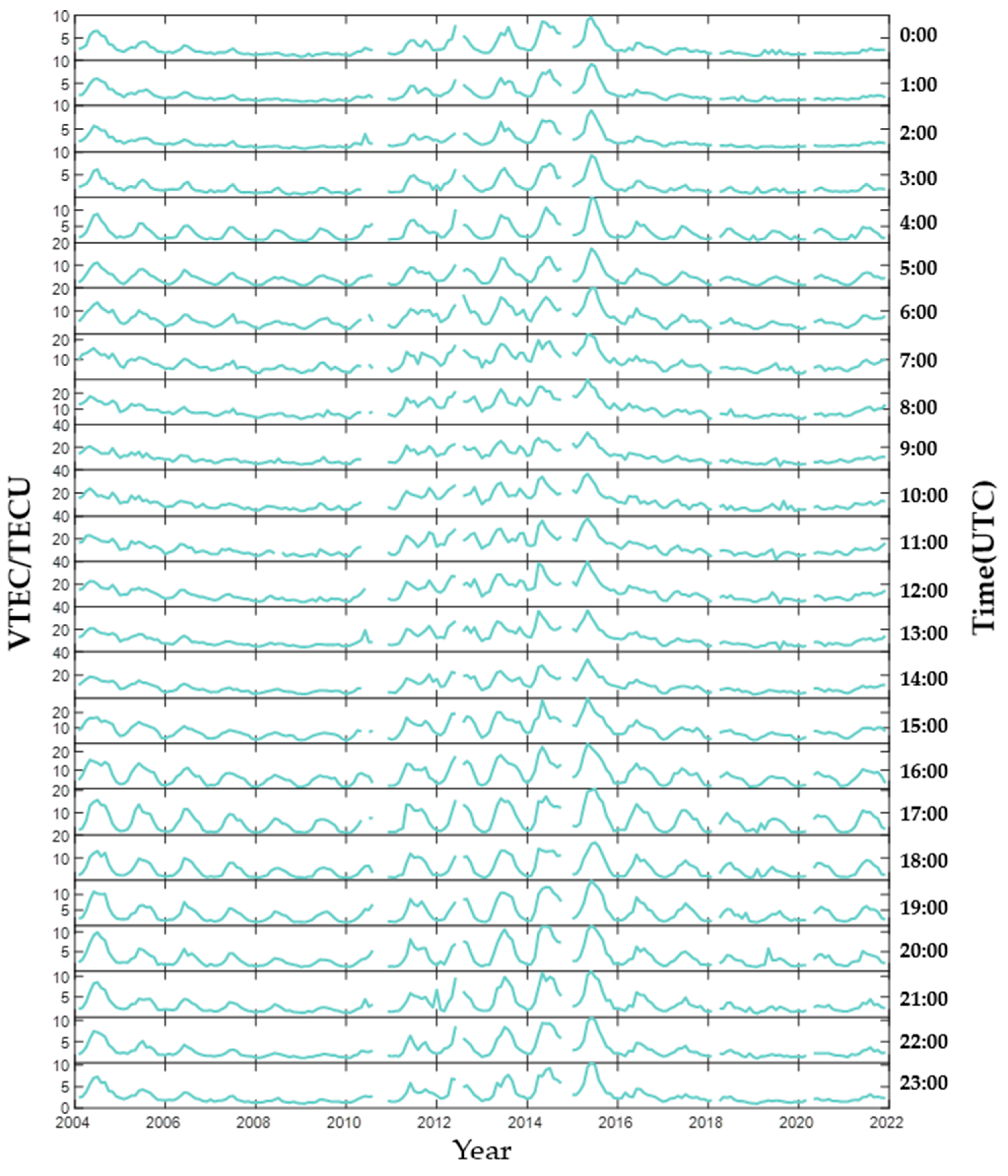




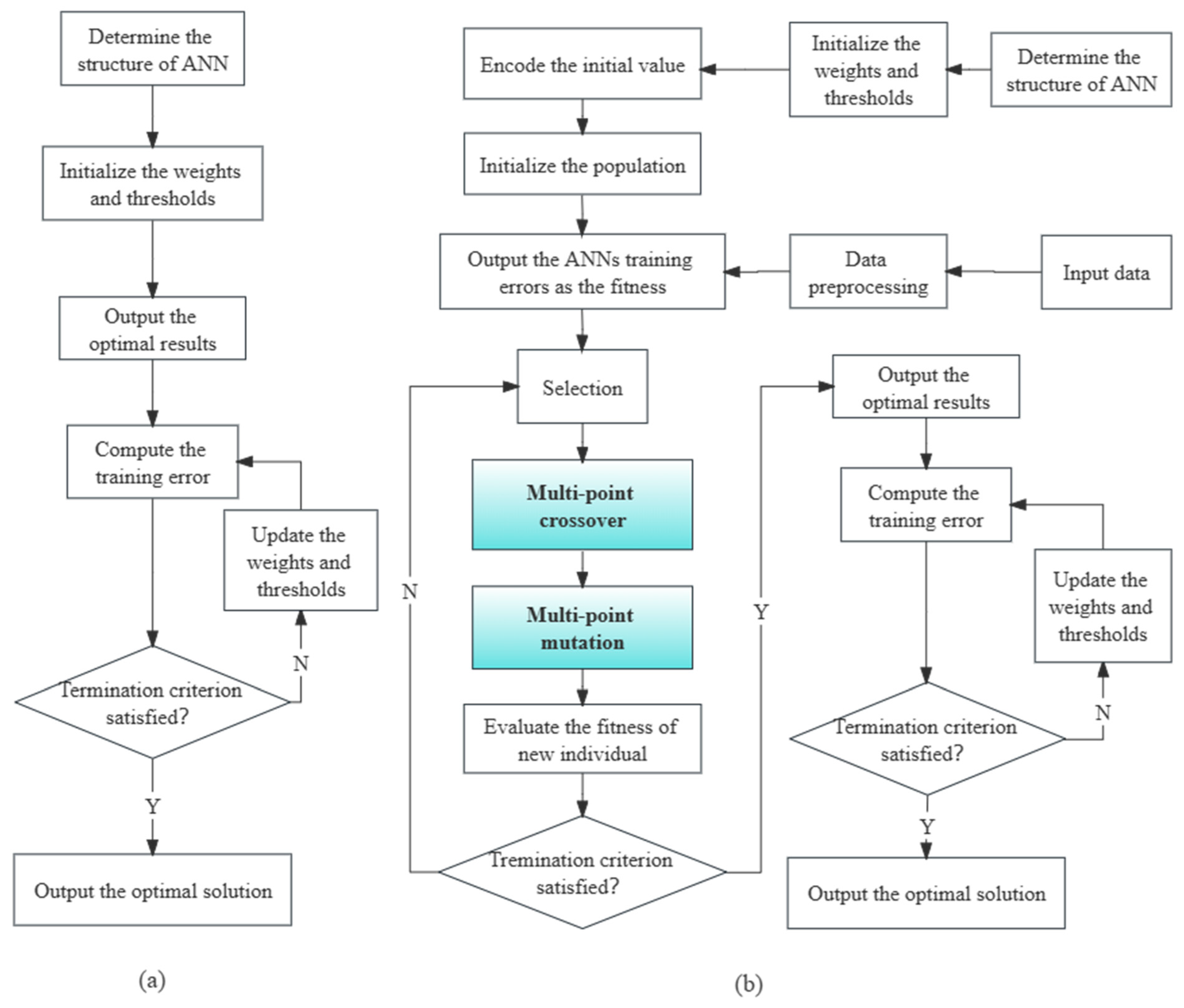
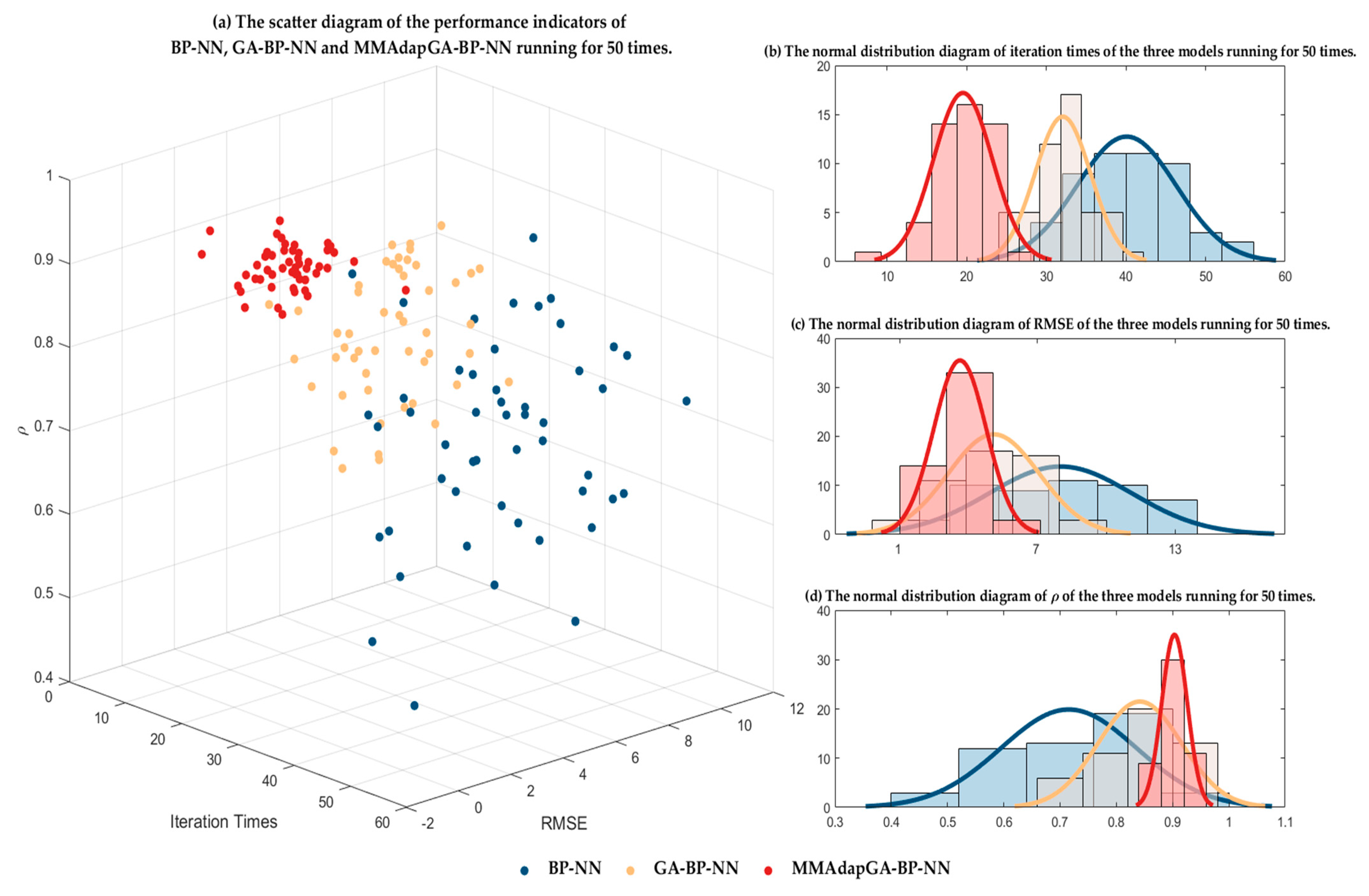

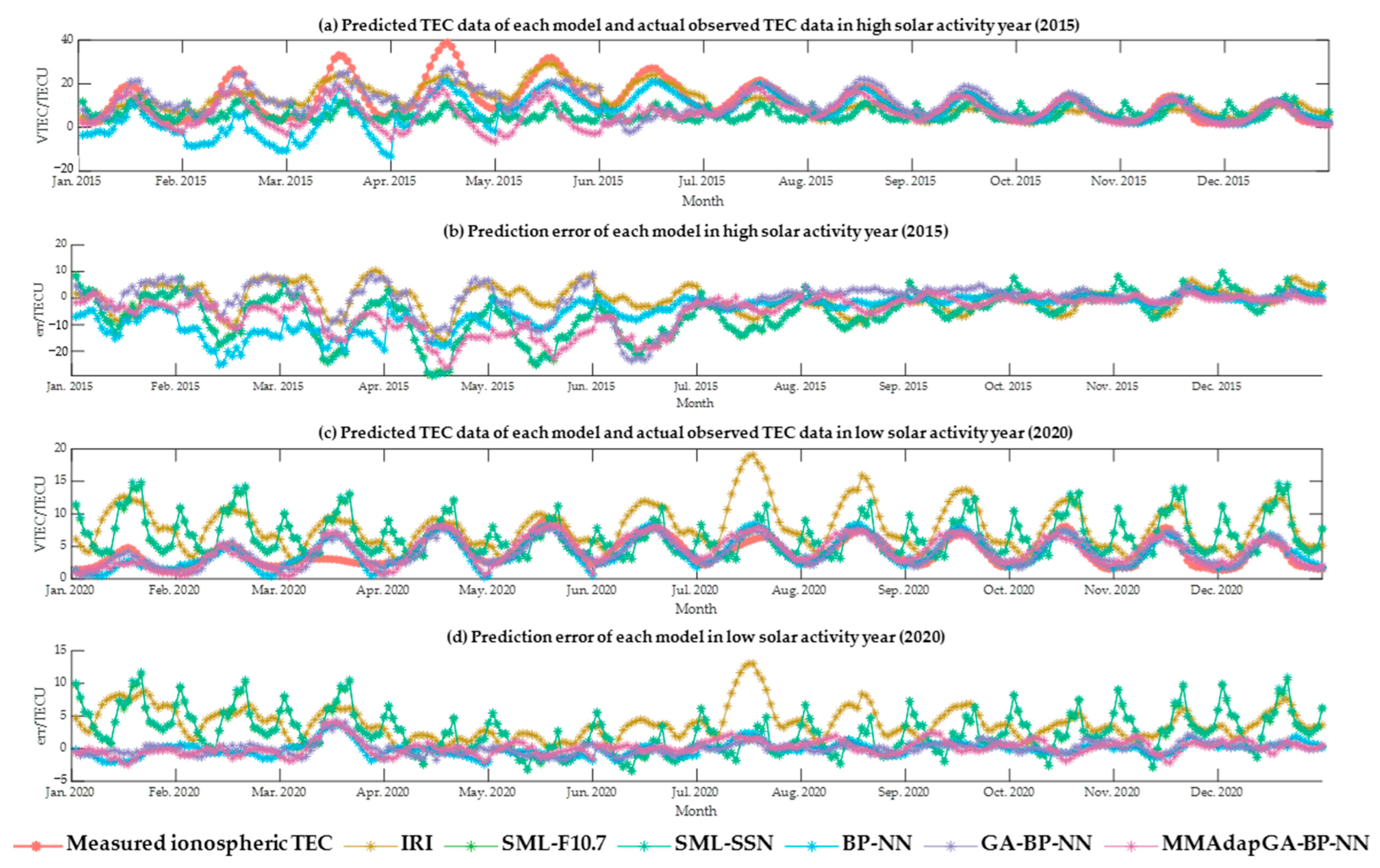
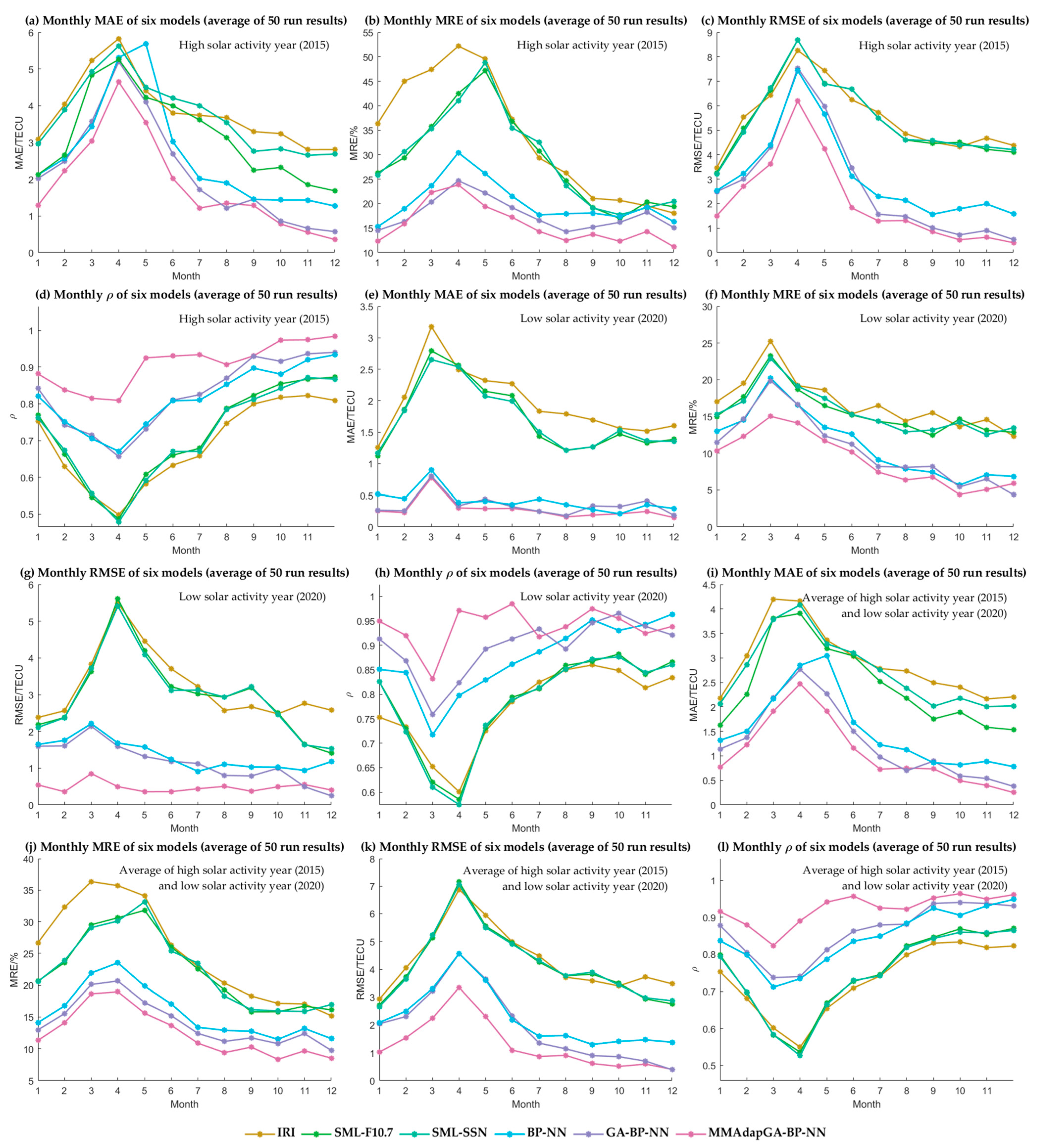
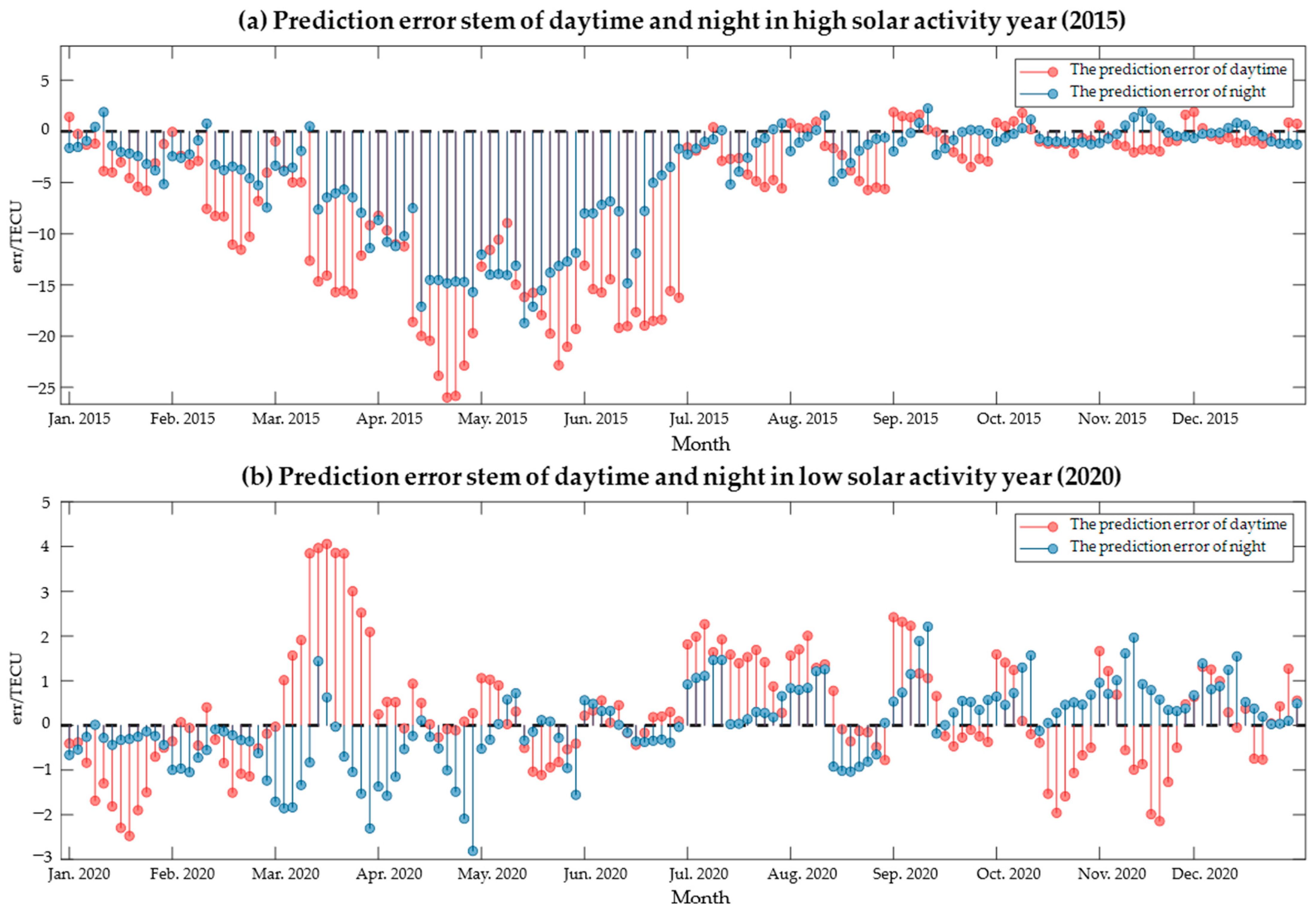
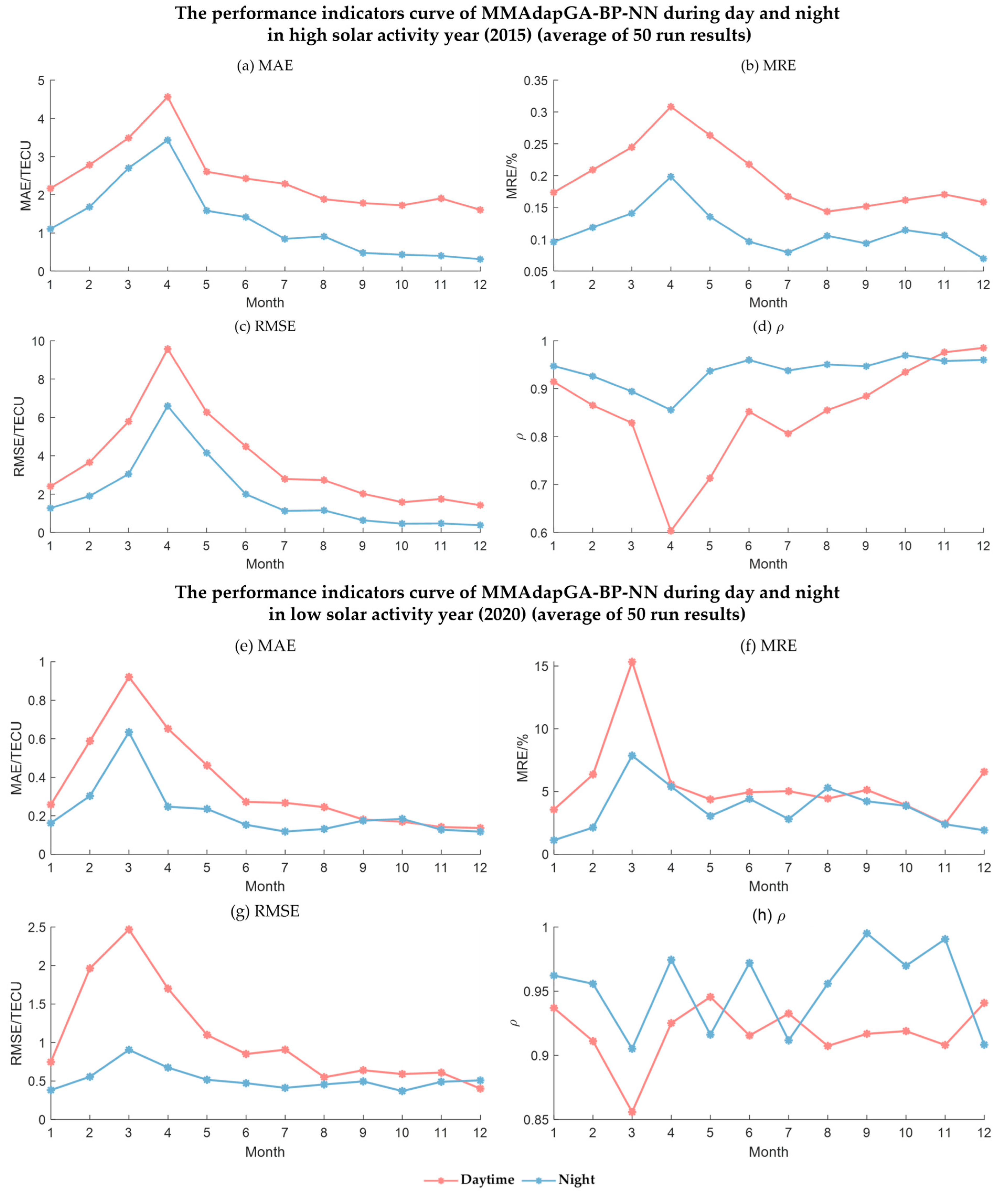

| Year | Performance | IRI-2020 | SML-F10.7 | SML-SSN | BP-NN | GA-BP-NN | MMAdapGA-BP-NN |
|---|---|---|---|---|---|---|---|
| High Solar Activity Year (2015) | MAE/TECU | 3.71 | 3.54 | 3.63 | 2.74 | 2.11 | 2.03 |
| MRE/% | 34.00 | 31.33 | 31.56 | 20.14 | 16.75 | 14.53 | |
| RMSE/TECU | 5.95 | 5.34 | 5.35 | 3.99 | 3.51 | 2.84 | |
| ρ | 0.75 | 0.79 | 0.77 | 0.82 | 0.85 | 0.91 | |
| Low Solar Activity Year (2020) | MAE/TECU | 1.92 | 1.51 | 1.56 | 0.41 | 0.34 | 0.28 |
| MRE/% | 18.23 | 16.12 | 16.24 | 6.04 | 5.27 | 3.54 | |
| RMSE/TECU | 3.05 | 2.87 | 2.96 | 1.12 | 1.03 | 0.85 | |
| ρ | 0.78 | 0.81 | 0.79 | 0.82 | 0.87 | 0.94 | |
| Mean Value | MAE/TECU | 2.82 | 2.56 | 2.60 | 1.58 | 1.23 | 1.16 |
| MRE/% | 28.12 | 23.84 | 23.79 | 19.09 | 16.01 | 13.54 | |
| RMSE/TECU | 4.62 | 4.34 | 4.31 | 3.06 | 2.76 | 1.94 | |
| ρ | 0.76 | 0.80 | 0.79 | 0.84 | 0.88 | 0.92 |
| Year | MAE/TECU | MRE/% | RMSE/TECU | ρ | |
|---|---|---|---|---|---|
| High Solar Activity Year (2015) | daytime | 2.45 | 19.75 | 3.65 | 0.82 |
| night | 1.34 | 10.21 | 2.35 | 0.94 | |
| Low Solar Activity Year (2020) | daytime | 0.37 | 5.42 | 1.04 | 0.90 |
| night | 0.19 | 2.13 | 0.63 | 0.97 | |
| Geomagnetic Activity | |
|---|---|
| >100 | Severe Storm |
| 50~99 | Major Storm |
| 30~49 | Minor Storm |
| 16~29 | Active |
| 8~15 | Unsettled |
| 0~7 | Quiet |
Disclaimer/Publisher’s Note: The statements, opinions and data contained in all publications are solely those of the individual author(s) and contributor(s) and not of MDPI and/or the editor(s). MDPI and/or the editor(s) disclaim responsibility for any injury to people or property resulting from any ideas, methods, instructions or products referred to in the content. |
© 2023 by the authors. Licensee MDPI, Basel, Switzerland. This article is an open access article distributed under the terms and conditions of the Creative Commons Attribution (CC BY) license (https://creativecommons.org/licenses/by/4.0/).
Share and Cite
Weng, J.; Liu, Y.; Wang, J. A Model-Assisted Combined Machine Learning Method for Ionospheric TEC Prediction. Remote Sens. 2023, 15, 2953. https://doi.org/10.3390/rs15122953
Weng J, Liu Y, Wang J. A Model-Assisted Combined Machine Learning Method for Ionospheric TEC Prediction. Remote Sensing. 2023; 15(12):2953. https://doi.org/10.3390/rs15122953
Chicago/Turabian StyleWeng, Jiaxuan, Yiran Liu, and Jian Wang. 2023. "A Model-Assisted Combined Machine Learning Method for Ionospheric TEC Prediction" Remote Sensing 15, no. 12: 2953. https://doi.org/10.3390/rs15122953
APA StyleWeng, J., Liu, Y., & Wang, J. (2023). A Model-Assisted Combined Machine Learning Method for Ionospheric TEC Prediction. Remote Sensing, 15(12), 2953. https://doi.org/10.3390/rs15122953







